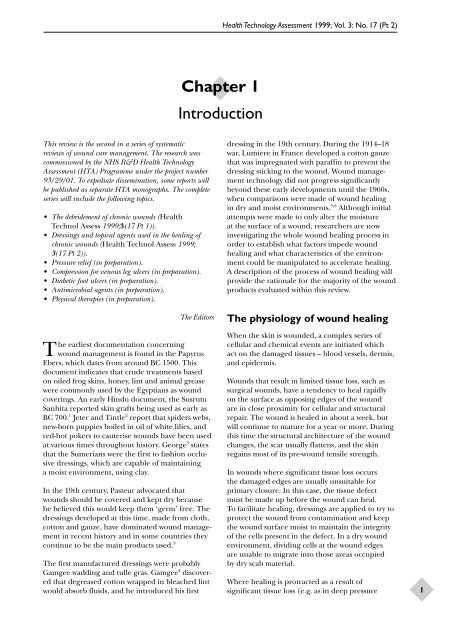Dressings and Topical Agents for Chronic Wounds - NIHR Health ...
Dressings and Topical Agents for Chronic Wounds - NIHR Health ...
Dressings and Topical Agents for Chronic Wounds - NIHR Health ...
Create successful ePaper yourself
Turn your PDF publications into a flip-book with our unique Google optimized e-Paper software.
<strong>Health</strong> Technology Assessment 1999; Vol. 3: No. 17 (Pt 2)Chapter 1IntroductionThis review is the second in a series of systematicreviews of wound care management. The research wascommissioned by the NHS R&D <strong>Health</strong> TechnologyAssessment (HTA) Programme under the project number93/29/01. To expediate dissemination, some reports willbe published as separate HTA monographs. The completeseries will include the following topics.• The debridement of chronic wounds (<strong>Health</strong>Technol Assess 1999;3(17 Pt 1)).• <strong>Dressings</strong> <strong>and</strong> topical agents used in the healing ofchronic wounds (<strong>Health</strong> Technol Assess 1999;3(17 Pt 2)).• Pressure relief (in preparation).• Compression <strong>for</strong> venous leg ulcers (in preparation).• Diabetic foot ulcers (in preparation).• Antimicrobial agents (in preparation).• Physical therapies (in preparation).The EditorsThe earliest documentation concerningwound management is found in the PapyrusEbers, which dates from around BC 1500. Thisdocument indicates that crude treatments basedon oiled frog skins, honey, lint <strong>and</strong> animal greasewere commonly used by the Egyptians as woundcoverings. An early Hindu document, the SusrutuSanhita reported skin grafts being used as early asBC 700. 1 Jeter <strong>and</strong> Tintle 2 report that spiders webs,new-born puppies boiled in oil of white lilies, <strong>and</strong>red-hot pokers to cauterise wounds have been usedat various times throughout history. George 3 statesthat the Sumerians were the first to fashion occlusivedressings, which are capable of maintaininga moist environment, using clay.In the 19th century, Pasteur advocated thatwounds should be covered <strong>and</strong> kept dry becausehe believed this would keep them ‘germ’ free. Thedressings developed at this time, made from cloth,cotton <strong>and</strong> gauze, have dominated wound managementin recent history <strong>and</strong> in some countries theycontinue to be the main products used. 3The first manufactured dressings were probablyGamgee wadding <strong>and</strong> tulle gras. Gamgee 4 discoveredthat degreased cotton wrapped in bleached lintwould absorb fluids, <strong>and</strong> he introduced his firstdressing in the 19th century. During the 1914–18war, Lumiere in France developed a cotton gauzethat was impregnated with paraffin to prevent thedressing sticking to the wound. Wound managementtechnology did not progress significantlybeyond these early developments until the 1960s,when comparisons were made of wound healingin dry <strong>and</strong> moist environments. 5,6 Although initialattempts were made to only alter the moistureat the surface of a wound, researchers are nowinvestigating the whole wound healing process inorder to establish what factors impede woundhealing <strong>and</strong> what characteristics of the environmentcould be manipulated to accelerate healing.A description of the process of wound healing willprovide the rationale <strong>for</strong> the majority of the woundproducts evaluated within this review.The physiology of wound healingWhen the skin is wounded, a complex series ofcellular <strong>and</strong> chemical events are initiated whichact on the damaged tissues – blood vessels, dermis,<strong>and</strong> epidermis.<strong>Wounds</strong> that result in limited tissue loss, such assurgical wounds, have a tendency to heal rapidlyon the surface as opposing edges of the woundare in close proximity <strong>for</strong> cellular <strong>and</strong> structuralrepair. The wound is healed in about a week, butwill continue to mature <strong>for</strong> a year or more. Duringthis time the structural architecture of the woundchanges, the scar usually flattens, <strong>and</strong> the skinregains most of its pre-wound tensile strength.In wounds where significant tissue loss occursthe damaged edges are usually unsuitable <strong>for</strong>primary closure. In this case, the tissue defectmust be made up be<strong>for</strong>e the wound can heal.To facilitate healing, dressings are applied to try toprotect the wound from contamination <strong>and</strong> keepthe wound surface moist to maintain the integrityof the cells present in the defect. In a dry woundenvironment, dividing cells at the wound edgesare unable to migrate into those areas occupiedby dry scab material.Where healing is protracted as a result ofsignificant tissue loss (e.g. as in deep pressure1
















